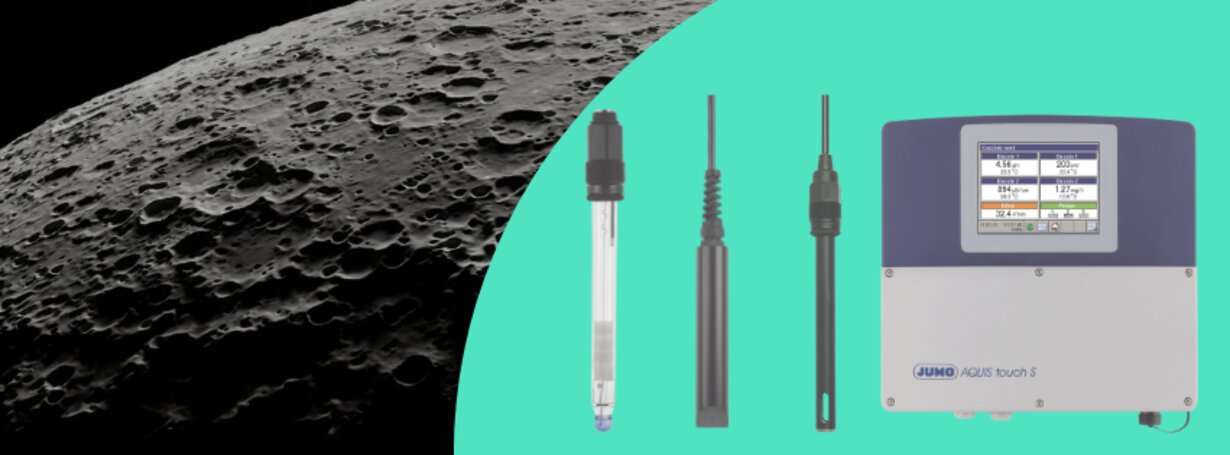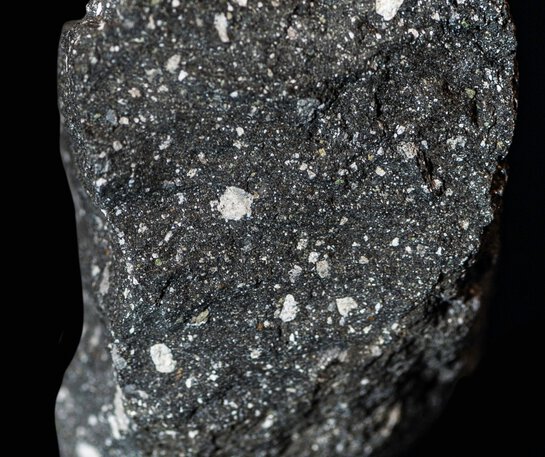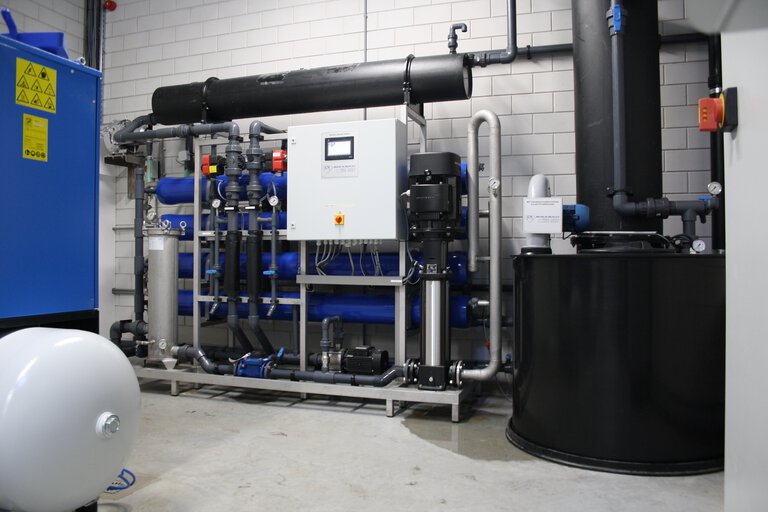

How does process water treatment contribute to space exploration? Measurement of conductivity, pH and turbidity of lunar water – a case study
Providing clean water to astronauts has been one of the biggest challenges of space missions. Transporting water from Earth was expensive and risky, so scientists worked on technologies to extract and purify water ice trapped in regolith, the rock covering the surface of the Moon. The European Union funded the LUWEX project, which aimed to develop technologies for extracting and treating lunar water for fuel and drinking water production. Scientists from the Wrocław University of Science and Technology took part in the project, studying the quality of water obtained from simulated lunar ice. JUMO supported the project by providing advanced measurement systems for monitoring water parameters such as conductivity, pH and turbidity. In this case study, you will learn how this collaboration contributed to groundbreaking discoveries in the field of water extraction and treatment in space. You will learn about the innovative technological solutions, the challenges involved in the project, and the prospects that have opened up for future space exploration. Read on to find out how JUMO supported space expeditions by providing innovative measurement technologies!
Could ice trapped in rocks on the Moon revolutionise future space missions?
Imagine you are an astronaut on a mission to the Moon. Around you stretches an endless lunar landscape, dotted with craters and rocks. Although Earth is visible, it seems distant, almost surreal. In this harsh and inhospitable setting, water becomes a priceless commodity. This is all the more true as technology advances and plans to conquer space become bolder – with longer manned missions, the construction of bases on the Moon, and perhaps even flights to other planets – the demand for water is growing.
Access to clean water in space is not just a matter of survival for astronauts. It is the key to the development of sustainable space exploration, which minimises the impact of missions on Earth and opens up new opportunities for us. Transporting water from Earth for space missions is extremely expensive and risky. Every kilogram of cargo delivered into orbit involves expenditure and the risk of failure during launch or transport. Furthermore, space exploration cannot come at the expense of Earth – we must strive for a sustainable approach that minimises our impact on the planet. What is more, reducing the amount of water transported would free up valuable space in rockets, allowing additional research equipment to be taken on board, which would increase the scientific and exploration capabilities of each mission. Therefore, searches for alternative sources of water in space have been conducted, during which it was discovered that there is ice beneath the surface of lunar rock, known as regolith. Obtaining water from these sources would reduce the cost of space missions, limit the consumption of Earth's resources and reduce the amount of cargo transported from our planet.
The LUWEX project: a revolution in water extraction on the Moon
To put this concept into practice, the European Commission funded the pioneering LUWEX (Validation of Lunar Water Extraction and Purification Technologies for In-Situ Propellant and Consumables Production) project. Its main objective was to develop technologies for extracting, purifying and storing water from lunar regolith. Research teams from Germany (German Aerospace Centre – project coordinator, Technical University of Brunswick), Poland (Wrocław University of Technology, Scanway Sp. z o.o.), Italy (Thales Alenia Space Italia) and Austria (LIQUIFER Systems Group) participated in the project. Thanks to international cooperation, the LUWEX project has significantly accelerated the development of technologies necessary for sustainable exploration of the Moon and paved the way for future space missions based on the use of local resources.
Technical and logistical challenges in obtaining water on the Moon
Obtaining and treating water on the Moon presented numerous challenges. Firstly, water is found there exclusively in the form of ice, which required the development of specialised extraction methods. Secondly, regolith contains contaminants that had to be removed to make the water safe for consumption. The purification process had to be energy-efficient and reliable to withstand the harsh lunar conditions. An additional challenge was logistics – transporting equipment to the Moon and ensuring its operation in extreme temperatures and vacuum conditions. This required close cooperation between international scientific and industrial teams.

Lunar regolith - a key component of the LUWEX project, from which water is extracted.
What was the significance of conductivity, pH and turbidity in the purification of moon water?
Although some of the tasks planned for the project were carried out in a laboratory on Earth at the Wrocław University of Science and Technology, the requirements for the quality of the water obtained were just as strict as those that will apply during actual space missions. Monitoring water quality was therefore a key element of the process that determined whether the technology would work on the Moon.
Three particularly important parameters were monitored during the tests: conductivity, pH and turbidity. These parameters were chosen because they provided quick, reliable and comprehensive information about both the chemical and physical condition of the water, while also enabling immediate identification of any technical problems in the water extraction and purification system. The conductivity of the water indicated its degree of mineralisation, i.e. the amount of dissolved salts and ions. Very low conductivity was required, especially when the water was to be subjected to electrolysis, as it ensured efficient decomposition into hydrogen and oxygen and protected the electrodes from contamination.
Ph, or the level of acidity or alkalinity of water, should have been as close to neutral (approx. 7) as possible. This pH value guaranteed that the water was safe to drink and that the treatment process had been carried out correctly, without the introduction of undesirable chemicals.
Turbidity, in turn, indicated the content of solid particles and suspended solids. Low turbidity indicated that the mechanical filters were working properly and that the water was clear and free of physical contaminants, which directly affected its safety and comfort of consumption. Thanks to continuous monitoring of this parameter, it was possible to quickly detect any mechanical failures, such as the ingress of regolith particles or damage to seals.
Continuous monitoring of these parameters allowed scientists to assess the effectiveness of individual stages of the purification process on an ongoing basis and to respond quickly to any technical problems. This made it possible to obtain water of the highest quality – ready for use in future space missions.
What requirements were set for measuring devices in the LUWEX project?
In the LUWEX project, the selection of appropriate measuring devices was crucial to the success of the entire undertaking. The research team from the Wrocław University of Technology thoroughly analysed the solutions available on the market, guided by several important criteria. First and foremost, the sensors had to ensure high accuracy and stability of measurements. The durability and reliability of the devices were also important, as they had to operate without interruption for long periods of time in a demanding environment. The team also paid attention to the manufacturer's experience in industrial applications, which increased the likelihood that the devices would perform well in conditions similar to those encountered during actual space missions. Another important factor was the ability to integrate seamlessly with the central control and data acquisition system so that measurements were available in real time and could be analysed immediately. By meeting these requirements, the measuring devices effectively supported the entire technological process.
When selecting components, quality was the top priority – accuracy, measurement stability and durability of these devices.
How does the process of treating water from regolith work?
Scientists from the Wrocław University of Technology chose JUMO measuring devices to monitor water quality in the LUWEX project. Two identical sets of sensors were used in the research installation – one placed before the start of the purification process (immediately after the condensation of water vapour on a cooled element, the so-called ‘cold finger’), and the other after the last stage of treatment, i.e. after the ion excha nge columns. Each of these sets consisted of three types of sensors:
- JUMO BlackLine CR-EC conductivity probes, which measured conductivity both before and after purification, allowing for precise assessment of the degree of water demineralisation and the effectiveness of the treatment processes.
- Digital optical turbidity probes JUMO ecoline NTU, which assessed the amount of solid particles at both stages, thus enabling accurate control of the mechanical filtration quality.
- JUMO Tecline glass pH electrodes monitored the pH level before and after the process, confirming that the water had reached a neutral pH and detecting any chemical irregularities at various stages of treatment.
Both sets of sensors were connected to the JUMO AQUIS touch P multi-channel controller for liquid analysis, which enabled data collection, integration and ongoing analysis in one place. The advantage of this device was its full integration with the central control computer, which collected data from all subsystems of the installation. This enabled the scientists to observe changes in water parameters in real time and make immediate decisions as soon as any irregularities arose.
‘We wanted process control, data acquisition, and analysis to be carried out by a single central system. [...] This is where the modular, multi-channel analyser from JUMO proved to be ideal, as it allows data to be transmitted in both digital and analogue formats. This was a huge help, especially for the engineers on the German side, who were able to access all the data they needed directly.’

From left: JUMO BlackLine CR-EC conductivity probes (202922), JUMO ecoline NTU digital optical turbidity probes (202670), JUMO tecLine glass pH electrodes (201020)
About the author
My name is Ewelina Szmit and I have been working in content marketing for several years, combining my professional skills with my passion for writing. I am convinced that even the most technical topics can be presented in an interesting and accessible way for everyone. Outside of work, I unleash my creativity by creating newspaper collages. I like to spend my free time being active, walking my dog or running.
Comments
We encourage you to leave your comments via the form below. They will be posted online once they have been approved through our review process.


